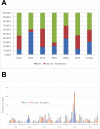The surveillance of the epidemiological and serotype characteristics of hand, foot, mouth disease in Neijiang city, China, 2010-2017: A retrospective study
- PMID: 31170178
- PMCID: PMC6553746
- DOI: 10.1371/journal.pone.0217474
The surveillance of the epidemiological and serotype characteristics of hand, foot, mouth disease in Neijiang city, China, 2010-2017: A retrospective study
Erratum in
-
Correction: The surveillance of the epidemiological and serotype characteristics of hand, foot, mouth disease in Neijiang city, China, 2010-2017: A retrospective study.PLoS One. 2019 Jul 10;14(7):e0219726. doi: 10.1371/journal.pone.0219726. eCollection 2019. PLoS One. 2019. PMID: 31291365 Free PMC article.
Abstract
Hand, foot, and mouth disease (HFMD) is well recognized as one of the major threats to children's health globally. The increasing complexity of the etiology of HFMD still challenges disease control in China. There is little surveillance of the molecular epidemiological characteristics of the enteroviruses (EVs) that cause HFMD in Neijiang city or the Sichuan Basin area in Southwest China. In this study, demographic and epidemiological information for 14,928 probable HFMD cases was extracted and analyzed to describe the epidemic features of HFMD in Neijiang city from Jan 2010 to Dec 2017. The swab samples of select probable HFMD cases from 2012 to 2017 were tested by reverse transcription (RT) real-time PCR to identify the serotype distribution of EVs, and 110 randomly selected RT-real-time PCR positive samples were then amplified and analyzed for the VP1 or VP4 regions of EVs to further analyze the phylogenetic characteristics of the circulating strains in this area. The eight-year average annual incidence was 49.82 per 100,000 in Neijiang. The incidence rates varied between 19.51 and 70.73 per 100,000, demonstrating peaks of incidence in even-number years (2012, 2014 and 2016). The median age of the probable cases was 27 months and the interquartile range (25th to 75th percentile) of ages for the probable HFMD cases was between 14 and 42 months. The male-to-female ratio of the probable HFMD cases was 1.47:1, and scattered children were the major population classification (81.7%). Two epidemic peaks were observed: one major peak between April and July and the other lesser peak between October and December. Of 6513 probable cases tested with RT-real-time PCR, 4015 (61.6%) were positive for enterovirus with the serotype distribution as follows: EV71+, 30.1% (n = 1210); CV-A16+, 28.7% (n = 1154) and a sole pan-enterovirus+, 41.1% (n = 1651). A total of 91 cases (82.7%, 91/110) were successfully amplified and underwent phylogenetic analysis: all EV71+ cases were C4a serotype (n = 23/30); all CV-A16+ cases were B2b serotype (n = 24/30); of 42 sole pan-enterovirus+ samples, 20 were CV-A6, 14 were CV-A10 and the rest within this group were CV-A4 (n = 4), CV-A8 (n = 2), CV-A9 (n = 1) and CV-B3 (n = 1). Our findings provide important evidence that aids the improvement of strategies for vaccination against HFMD and comprehensive disease control in China.
Conflict of interest statement
The authors have declared that no competing interests exist.
Figures






Similar articles
-
Epidemiological and serological surveillance of hand-foot-and-mouth disease in Shanghai, China, 2012-2016.Emerg Microbes Infect. 2018 Jan 24;7(1):8. doi: 10.1038/s41426-017-0011-z. Emerg Microbes Infect. 2018. PMID: 29362406 Free PMC article.
-
Surveillance for severe hand, foot, and mouth disease from 2009 to 2015 in Jiangsu province: epidemiology, etiology, and disease burden.BMC Infect Dis. 2019 Jan 22;19(1):79. doi: 10.1186/s12879-018-3659-7. BMC Infect Dis. 2019. PMID: 30669973 Free PMC article.
-
Epidemiological characterizations, pathogen spectrum and molecular characteristics of Coxsackievirus A16 from patients with HFMD in Yantai, Shandong, China between 2011 and 2015.Hum Vaccin Immunother. 2017 Aug 3;13(8):1831-1838. doi: 10.1080/21645515.2017.1318233. Epub 2017 May 24. Hum Vaccin Immunother. 2017. PMID: 28537484 Free PMC article.
-
Atypical hand-foot-mouth disease in Belém, Amazon region, northern Brazil, with detection of coxsackievirus A6.J Clin Virol. 2020 May;126:104307. doi: 10.1016/j.jcv.2020.104307. Epub 2020 Mar 6. J Clin Virol. 2020. PMID: 32302950 Review.
-
A review and meta-analysis of the epidemiology and clinical presentation of coxsackievirus A6 causing hand-foot-mouth disease in China and global implications.Rev Med Virol. 2020 Mar;30(2):e2087. doi: 10.1002/rmv.2087. Epub 2019 Dec 6. Rev Med Virol. 2020. PMID: 31811676 Review.
Cited by
-
A neonatal murine model of coxsackievirus A4 infection for evaluation of vaccines and antiviral drugs.Emerg Microbes Infect. 2019;8(1):1445-1455. doi: 10.1080/22221751.2019.1673135. Emerg Microbes Infect. 2019. PMID: 31595827 Free PMC article.
-
Association of CD14 rs2569190 G/A genetic polymorphism with the severity of enterovirus 71 infection in Chinese children.Virology. 2020 Sep;548:25-30. doi: 10.1016/j.virol.2020.06.001. Epub 2020 Jun 7. Virology. 2020. PMID: 32838942 Free PMC article. No abstract available.
-
Coxsackievirus B3 HFMD animal models in Syrian hamster and rhesus monkey.Virol Sin. 2024 Apr;39(2):290-300. doi: 10.1016/j.virs.2024.02.001. Epub 2024 Feb 6. Virol Sin. 2024. PMID: 38331038 Free PMC article.
-
Long-term sentinel surveillance of enteroviruses in Gwangju, South Korea, 2011-2020.Sci Rep. 2023 Feb 16;13(1):2798. doi: 10.1038/s41598-023-29461-8. Sci Rep. 2023. PMID: 36797345 Free PMC article.
-
Correction: The surveillance of the epidemiological and serotype characteristics of hand, foot, mouth disease in Neijiang city, China, 2010-2017: A retrospective study.PLoS One. 2019 Jul 10;14(7):e0219726. doi: 10.1371/journal.pone.0219726. eCollection 2019. PLoS One. 2019. PMID: 31291365 Free PMC article.
References
-
- China Statistical Yearbook, 2018. http://www.stats.gov.cn/tjsj/ndsj/2018/indexch.htm. Last access: 3/14/2019.
Publication types
MeSH terms
Substances
LinkOut - more resources
Full Text Sources
Research Materials
Miscellaneous

